|

by
Freddy Silva
from
AtlantisRising Website
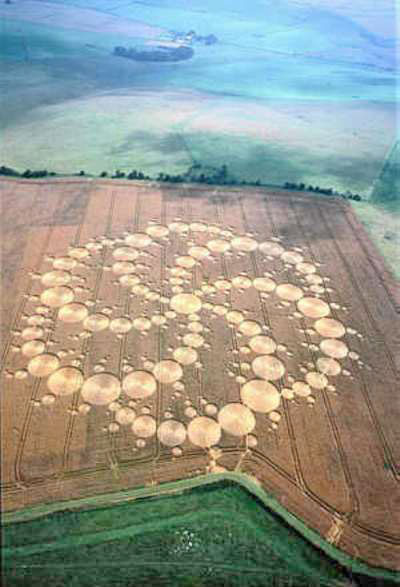
For over twenty years the normally
quaint and quiet English countryside has slowly been overrun by a
phenomenon more akin to It Came From Outer Space than to cream tea.
Fields long accustomed to entertaining wheat, barley, or canola are,
with increasing frequency, playing host to magnificent pictograms in
the form of crop circles: areas of flattened crop as large as
100,000 square feet where plants are bent an inch above soil level
and gently laid down in geometrically-precise pictograms, with no
visible signs of damage or human entry.
But what started as a local phenomenon in the environs of Stonehenge
and Silbury Hill has since become a major British export: to date,
some 8,000 crop circles have been reported worldwide.
If they had their way, certain television documentaries would have
you believe that all crop circles have been nothing more than the
work of two simple, elderly men armed with a plank of wood and a
baseball cap fitted with a ludicrous wire attachment which, they
claim, helped make mathematically correct circles and ruler-straight
lines in total darkness.
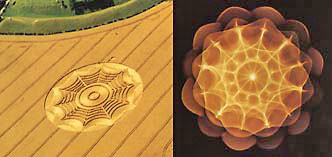
But in such programs the meat on the
bone of research is systematically stripped before it reaches the
table. The public is left to be turned off as the whole phenomenon
is explained through human agency alone. This is why there is so
much disbelief, even hostility, toward crop circles in the public's
mind. Yet despite persistent attempts, researchers, scientists and
hoaxers have failed to replicate most phenomena associated with
genuine crop circles: plants bent, not broken or damaged; radically
altered chromosomes; massive depletion of the groundwater; soil
element alterations; major discrepancies in background radiation and
electromagnetic fields, dowsable and long-lasting energy patterns;
and so on.
Most disturbing for hoax theory
advocates has been the discovery, by Emeritus Professor of Astronomy
Gerald Hawkins, of Euclidean geometry and diatonic ratios present in
crop circles features requiring a understanding beyond basic math
and yet to be found in both controlled man-made designs or in
uncontrolled hoaxes.
So much, then, for two guys and a long two-by-four. But what, then,
is causing several thousand square feet of crop to suddenly lay down
in designs of immense complexity and hypnotic beauty?
THE
GROUND COMPONENT
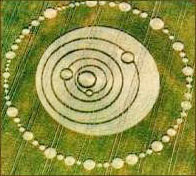 When
the stems of affected plants are cut, a malty fragrance is detected,
suggesting that they have been cooked from the inside. Yet the
stalks remain unharmed. A second observation reveals that a
noticeable amount of ground water in and around crop circles appears
to have vanished (this is corroborated by the author's infrared
photographic analysis). The soil within a formation is generally
dry, even cracked, despite overnight rains. When
the stems of affected plants are cut, a malty fragrance is detected,
suggesting that they have been cooked from the inside. Yet the
stalks remain unharmed. A second observation reveals that a
noticeable amount of ground water in and around crop circles appears
to have vanished (this is corroborated by the author's infrared
photographic analysis). The soil within a formation is generally
dry, even cracked, despite overnight rains.
Exhaustive lab analysis into hundreds of
crop circles from 1991 to 1995 by biophysicist Dr. W.C. Levengood
reveals physical and biophysical changes in plants inside crop
circles. Their nodes are literally blown open to form expulsion
cavities, an effect unique to crop formations and reproduced in a
lab setting through a very rapid rate of heating. Levengood also
discovered alterations in the germination and development of seed
embryos, alterations in plant stem node length and circumference (up
to 200% in one case), and enlarged cell wall pit diameters in bract
tissue actions consistent with the application of intense heat.
This leads to the speculation that the affected plants are
microwaved for a very intense yet brief period. The groundwater is
partly vaporized, partly sucked into the plant, thereby preventing
the field from catching fire, while the stems are made supple enough
to bend without cracking, enabling them to be easily manipulated
into precise patterns. But this does not account for the geometric
designs.
THE
GEOMETRIC COMPONENT
Look through twenty years of aerial photos of these agriglyphs and
it is hard to deny their melodic precision, their circular forms
resplendent with abstract, yet harmonic waves of invisible energy.
Hardly surprising, then, to discover crop circle
 designs
flaunting the principles of sacred geometry, either visually or
veiled within the construction blueprint, much in the same way
ancient esoteric knowledge was hidden within the framework of
religious fables or monuments. designs
flaunting the principles of sacred geometry, either visually or
veiled within the construction blueprint, much in the same way
ancient esoteric knowledge was hidden within the framework of
religious fables or monuments.
In his visionary work, The Sophistication of Agriglyth Geometry,
John Martineau was perhaps the first to visualize this coded
information in the early phases of the phenomenon. My own
dissections of aerial photographs also prove the same to be true of
designs in recent years. Even what sometimes appear to be loose or
random elements both within and beyond the perimeter of formations
such as small unconnected circles or grapeshot,' and rectangular
boxes are placed along an invisible matrix of pentagonal and
hexagonal alignments based on proportional geometry and Golden Mean
ratios.
In Science News (Feb. 1992), Prof. Hawkins went a step further by
using the principles of Euclidean geometry to prove that four
theorems could be derived from the relationships among the elements
in crop circles. More significantly, he discovered a fifth theorem
from which he could derive the other four. Despite an open
challenge, tens of thousands of subscribers to both Science News and
Mathematics Teacher were unable to create such a theorem, which
Euclid himself had only hinted at twenty-three centuries earlier. It
subsequently appeared as flattened barley at Litchfield, England, in
1995.
THE
SOUND COMPONENT
Ancient Greeks once remarked that geometry is frozen music. To their
Egyptian teachers, sacred geometry and music were inextricably
linked since the laws of the former govern the mathematical
intervals that make up the notes in the western music scale the
diatonic ratios. Coincidentally, Hawkins' Euclidean theorems had
also produced diatonic ratios. So for the first time, geometric
theorems were linked with music and crop circles were proved to
contain musical notes, which are themselves the by-product of the
harmonic laws of sound frequency.
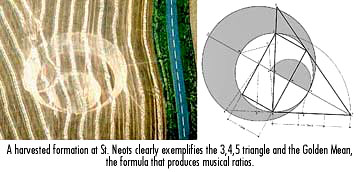
The fields themselves offered blatant
clues pointing to a sound component. In 1996 a crop circle
demonstrated the combination of two important figures, the 3, 4, 5
triangle and the Golden Mean, which gives us the diagram necessary
to produce musical ratios (as exemplified in
The Divine Proportion
by H.E.Huntley).
Then an outstanding formation at Goodwood Clatford which had its
plants bent six inches from the top gave the proverbial nod to
sound. For here was a cymatic pattern in 5,000 square feet of
barley, leading straight to a smoking gun.
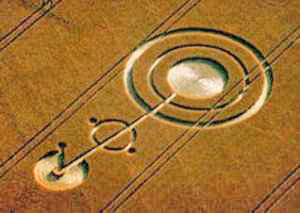 In
1967, Swiss scientist Hans Jenny published the first of his
painstaking studies of vibrational affects on physical media such as
water, plaster, oil and sand cymatics. By transmitting sound in the
shape of a monitored frequency through these elements, he was able
to capture on film the exact geometric pattern that sound makes as
its vibrations move through these substances. In
1967, Swiss scientist Hans Jenny published the first of his
painstaking studies of vibrational affects on physical media such as
water, plaster, oil and sand cymatics. By transmitting sound in the
shape of a monitored frequency through these elements, he was able
to capture on film the exact geometric pattern that sound makes as
its vibrations move through these substances.
Changing the vibration altered the shape
of the geometry captured in the receiving substance a low frequency
produced a simple circle encompassed by a ring, whereas a higher
frequency increased the number of concentric rings around a central
circle. As the frequencies rose, so too did the complexity of
shapes, to the point where tetrahedrons, mandalas, and Pythagorean
forms were discernible. Jenny not only managed to solidify sound, he
also enabled humanity to observe frozen music.
Jenny also provided a physical connection to the creation of crop
circles, since many of the vibrational patterns found in his photos
mimicked their designs. Some were blatant imitations, such as a
circle surrounded by concentric rings from the 80s, the tetrahedron
at Barbury Castle in 1991, the mandalas and spider's web of 1994,
even the highly structured Pythagorean-based star fractals of 1997.
Other photos demonstrated the construction geometry encoded within
crop circles but only visible upon dissection of overhead
photographs by compass or computer.
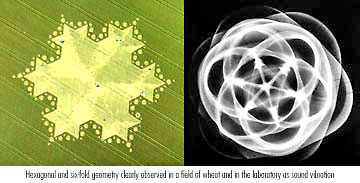
But there is yet another coincidence:
the relationship between the rising complexity of Jenny's cymatic
geometries in proportion to the rise of dispensed frequency matches
the historical sequential development of the pictograms. Crop
circles began appearing as simple circles in the '70s and developed
in an exponential curve through the 80s and into today's complex
pictograms, much in the same way Jenny's work shows the increase in
design complexity relative to the rise in frequency applied.
This coincidence echoes the repeated claims by many channelers/mediums/sensitive
people at the beginning phase of the phenomenon that the
earth is
undergoing a change in frequency a raising in the earth's vibratory
rate, a sentiment also shared in the prophecies of native tribes
around the world concerning earth changes of this period. Further
corroboration comes from NASA, whose recent soundings of earth from
space record a rise in the frequency hum' emitted by the planet.
In his extensive database, leading crop circle researcher
Colin Andrews notes several
accounts of a trilling sound heard by people prior to witnessing
crop circles forming. The reports describe a total stillness in the
air; the morning song of birds stops, proceeded by a trilling sound
and the banging together of wheat heads despite an absence of wind.
The crop then lies down in spiral fashion, the whole episode lasting
no more than fifteen seconds.
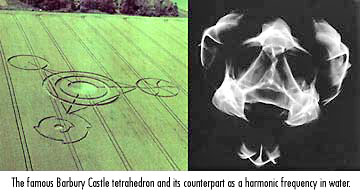
This sound was eventually captured on
magnetic tape and analyzed at NASA's Jet Propulsion Lab as
mechanical in nature and beating at a frequency of 5.2kHz. The same
sound had been previously heard by a BBC cameraman while recording
an interview near a crop circle, shortly before crossing the
formation's threshold, which proceeded to render two $50,000 TV
cameras obsolete. Obviously, if sound is a main component in the
creation of crop circles it can certainly be interacted with.
The formations' physical location may play a part in this. In
Dowsing Crop Circles, two decades of collective research by noted
dowsers Richard Andrews and Hamish Miller, among others, reveals
that crop circles have been materializing over major
ley lines the
earth's magnetic energy grid or their tributaries. Miller had also
observed, together with Paul Broadhurst in The Sun and the Serpent,
how this energy congregates at stone circles and tumuli. Imagine his
surprise to find crop circles energetically linked to these ancient
sites and their magnetic grid.
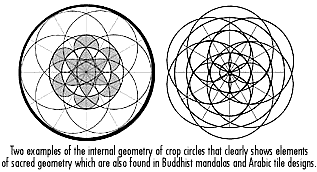
In noted cases such as the cyclopean
triple Julia Set fractal formation at Windmill Hill in 1996, crop
circles appear over the node point where the male and female lines
intersect and discharge dowsable patterns of energy. These invisible
fingerprints, which can last up to a year after all visible signs of
the formation have been tilled, were discovered by Miller to have
coherent geometric structures Teutonic crosses, 9-, 10- and
12-pointed stars, the same geometric patterns which formed part of
esoteric mathematical teaching in Egyptian, Buddhist, and Arabic
cultures, and since popularized in the West by Pythagoras.
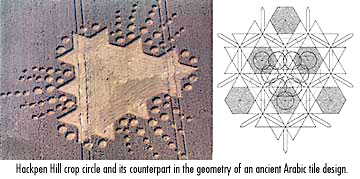
This relationship between geometry,
math, and music is especially important in Buddhist mandalas, whose
elaborate geometries are claimed to be the physical manifestation of
chants which are then used for meditation. In Arabic culture these
relationships have been meticulously preserved in ceramic tile
design. In both cases, the geometry mirrors crop circle designs in
either their outward appearance or in their respective construction
skeleton which, in turn, bear a familiarity to Jenny's photographic
evidence.
It's no coincidence that a large percentage of crop circles can be
identified with and by ancient cultures. To this day their histories
are honored through song and music, their healing rituals performed
with sound or rhythm. In
Secrets of the Soil, Peter Tomkins reveals
how
Hopi natives danced in a field during a severe drought, chanting
specific notes. By harvest time the only area in the vicinity to
yield a harvestable crop was the one exposed to their vibratory
tones. A parallel situation exists in England, where farmers whose
fields have played host to genuine crop circles report an increase
in yield and healthier-looking, pest-resistant plants.
As Robert Lawlor once wrote in Sacred Geometry,
Both our organs of
perception and the phenomenal world we perceive seem to be best
understood as systems of pure pattern, or as geometric structures of
form and proportion.
Therefore, when many ancient cultures chose to
examine reality through the metaphors of geometry and music they
were already very close to the position of our most contemporary
science. The musical scale, constructed on the harmonics of
sacred
geometry, and now found within the framework of crop circles,
represents the mathematical structure of the soul of the world
because it
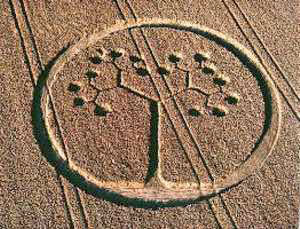 embodies
the essence of the universe modeled on it. embodies
the essence of the universe modeled on it.
Could it be, by implication, that crop circles are the universal
language?
In them we see the embodiment of musical and geometrical elements as
they give rise to designs of perfect symmetry, proportion, and
harmony. This may explain why people just aren't as aroused by
man-made formations regardless of how coherent they look, especially
from the air their ratios are off the mark and fail to activate a
harmonic vibration within the viewer.
The same applies to a genuine crop circle: distort or remove just
one element and the communication between viewer and design is
short-circuited. It simply becomes a work of art without meaning.
But show people a mere photo of the real thing and their eyes light
up, they become emotional, lightheaded, ecstatic, benevolent, dizzy,
even noxious. In stark contrast, a hoaxed crop circle provokes
apathetic, even negative reactions.
Perhaps what the viewer recognizes is a basic language common to all
nature but only retrievable by the subconscious. Our eyes may be
attracted to the designs in golden wheat but the real message is
reached at a deeper level, triggered by an underlying code based on
sacred geometry the very same code upon which nature is created, and
whose formulas were zealously guarded by ancient esoterics as the
knowledge of the Godly.
What we are reading in the fields of England and now throughout the
world could very well be the book of universal law.
|



 When
the stems of affected plants are cut, a malty fragrance is detected,
suggesting that they have been cooked from the inside. Yet the
stalks remain unharmed. A second observation reveals that a
noticeable amount of ground water in and around crop circles appears
to have vanished (this is corroborated by the author's infrared
photographic analysis). The soil within a formation is generally
dry, even cracked, despite overnight rains.
When
the stems of affected plants are cut, a malty fragrance is detected,
suggesting that they have been cooked from the inside. Yet the
stalks remain unharmed. A second observation reveals that a
noticeable amount of ground water in and around crop circles appears
to have vanished (this is corroborated by the author's infrared
photographic analysis). The soil within a formation is generally
dry, even cracked, despite overnight rains.  designs
flaunting the principles of sacred geometry, either visually or
veiled within the construction blueprint, much in the same way
ancient esoteric knowledge was hidden within the framework of
religious fables or monuments.
designs
flaunting the principles of sacred geometry, either visually or
veiled within the construction blueprint, much in the same way
ancient esoteric knowledge was hidden within the framework of
religious fables or monuments.
 In
1967, Swiss scientist Hans Jenny published the first of his
painstaking studies of vibrational affects on physical media such as
water, plaster, oil and sand cymatics. By transmitting sound in the
shape of a monitored frequency through these elements, he was able
to capture on film the exact geometric pattern that sound makes as
its vibrations move through these substances.
In
1967, Swiss scientist Hans Jenny published the first of his
painstaking studies of vibrational affects on physical media such as
water, plaster, oil and sand cymatics. By transmitting sound in the
shape of a monitored frequency through these elements, he was able
to capture on film the exact geometric pattern that sound makes as
its vibrations move through these substances. 



 embodies
the essence of the universe modeled on it.
embodies
the essence of the universe modeled on it.